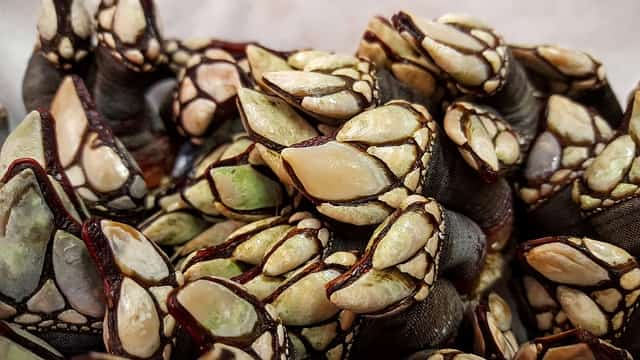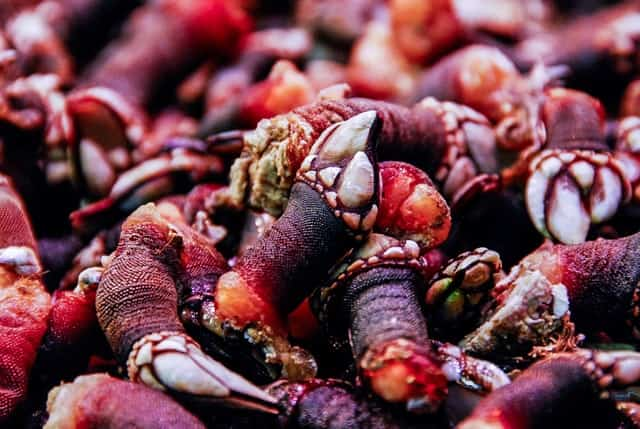Gooseneck barnacles are sessile filter feeders that belong to the crustacean family alongside shrimp, crabs, crayfish, prawns, and lobster. As noted, some people refer to these strange sea organisms as goose barnacles or stalked barnacles. Usually, they attach themselves to rock surfaces using a strong stalk and mostly appear in the ocean intertidal zone. They might also grow on flotsam and other materials at sea. Gooseneck barnacles eat planktons (tiny organisms drifting on water and a important food source for aquatic life).
Goose barnacles do not only grow in Europe. Reports indicate that one also can find them in North America, South America, and Africa. Several species appear in tropical and temperate oceans. As noted, Pollicipes pollicipes is the most common species. Others include Pollicipes polymerus, Pollicipes caboverdensis, and Pollicipes elegans.
What Makes Gooseneck Barnacles So Expensive?
Many do not know that gooseneck barnacles are a kind of seafood and a delicacy in Portugal and Spain. They are equivalent to caviar in the United States. In Spanish and Portuguese cuisine, people refer to them as percebes. They are among the most expensive seafood in the world right now. A pound of gooseneck barnacles can cost more than $100.
They cost several times higher than your ordinary seafood. Generally, they fetch higher prices because they are rare. The harvesters also face grave risks, and some die in the process. Research shows about five people die every year as they attempt to harvest goose barnacles. The danger comes from rough weather in the intertidal zone, thrusting waves, and rocky shores.

The harvesters also usually have a few hours each day to gather gooseneck barnacles. They only harvest them when there is a low tide and must pull out whenever intertidal zone conditions change. As a result, they must constantly monitor tidal changes even as they do their job.
They must remain vigilant because falling into the water can prove deadly, considering the intertidal zone has strong, pounding waves. The risk grows substantially when harvesters want to fetch the best quality and hard-to-remove gooseneck barnacles growing on rock edges.
In addition, the harvesting process is slow despite the short low-tide window. Harvesters should do it carefully to ensure the barnacle is intact or otherwise risk lowering the quality of the product.
Gooseneck barnacles are also expensive because most regions have restrictions on the amount individuals can harvest in a given period. In California, it is completely illegal to collect gooseneck barnacles. Even so, Oregon allows collection on jetties but not natural rock formations. Thus, the demand for gooseneck barnacles is always higher than supply, making this seafood rare and expensive.
Amazing Nutrition Facts about Gooseneck barnacles
Gooseneck barnacles have an interesting nutritional profile that makes them worth trying. Research indicates that water makes up 90% percent of these crustaceans. Every 100 g of gooseneck barnacle meat supplies 66 calories. Beyond this, this delicacy provides protein (4%) and fats (5%). It is also a source of minerals and vitamins. It is specifically rich in potassium, vitamin B1, and vitamin B2.
Potassium is good for the heart. It keeps electrical signals in the myocardium well regulated and helps maintain regular heartbeats. In addition, it promotes good cardiovascular health by ensuring heart muscles contract and function optimally. It further controls sodium concentrations in the body and maintains good blood pressure.
Vitamin B1(thiamine) is an essential nutrient that plays a significant role in glucose metabolism. It promotes cell growth and development. It is also a vital in maintaining good nerve, muscle, brain, and cardiovascular function.
Vitamin B2 (riboflavin) in gooseneck barnacles generally aids in lipid or fat metabolism. It also contributes to optimal cellular growth, development, and function. In addition, this vitamin helps prevent cancer by reducing DNA damage in healthy people. Vitamin B2 is further beneficial to people with migraine headaches, acne, Alzheimer’s disease, muscle cramps, cataracts, and carpal tunnel syndrome.
Storage Conditions
The goose barnacles harvested for food are best prepared fresh because their quality declines rapidly. Freezing them negatively affects their texture and flavor. As a result, they lose their value and might not fetch as much as when delivered fresh.
Gooseneck Barnacle Grading
The amount of meat goose barnacles hold determines their grade. The grades usually range from A, B, and C. Grade A barnacles have the most meat and often look fuller, more firm, and aesthetically appealing. By contrast, grades B and C include barnacles of lesser quality.
How to Prepare Gooseneck Barnacle (Percebes)
The most common method of preparing these crustaceans is adding salt and water. It helps preserve as much original flavor as possible. However, you can decide to add a new twist, depending on personal preference. In this case, you might consider adding bay leaf and lemon. You should cook them for about 2-3 minutes. Cooked barnacles usually turn deep pink.

How to Eat Gooseneck Barnacles (Percebes)
A gooseneck barnacle has two parts comprising an edible peduncle or stalk and the inedible capitulum (barnacle’s nail). Usually, you pick a cooked barnacle and remove the outer casing to reveal the bright orange flesh inside. Cutting with scissors may help remove the tough dark brown skin. Generally, gooseneck barnacles taste close to cooked lobster, shrimp, clam, or crab.
Frequently Asked Questions About Gooseneck Barnacles
Are barnacles healthy to eat?
Yes! Gooseneck barnacles are perfectly healthy and safe to eat. In fact, they are an expensive delicacy in many countries around the world. In Portugal and Spain, barnacles or percebes (perceves) are considered a rare and luxury treat. They have a sweet and slightly briny taste with a rich nutritional profile that appeals to seafood lovers.
Can you eat gooseneck barnacles raw?
Yes! You can eat gooseneck barnacles raw. However, eating raw barnacles comes with risks, as they may contain harmful bacteria. Raw barnacles may also have an unpleasant texture. Therefore, it is always good to stem or boil them. It improves flavor and texture and kills harmful bacteria.
Can you eat all barnacles?
No! It is not safe to eat just any type of barnacle you find. In fact, there are only two edible species of barnacles out of over 1,400 known species. In this sense, the odds of eating the wrong type of barnacle is very high. The only edible species of barnacles include gooseneck barnacles and acorn barnacles.